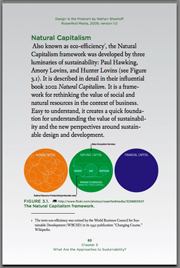This review is from an online newsletter on lifecycle design issues (covering LCA design tools and related teaching tools such as powerpoint slides) over at The Designer’s Atlas of Sustainability.
Design is the Problem: The Future of Design Must be Sustainable by Nathan Shedroff (Rosenfeld Media 2009)

There is much to like in Nathan Shedroff’s new book, Design is the Problem, which is a survey of sustainable design approaches that can be applied across the lifecycle of products. Shedroff also provides contextual and background information about sustainable design in a business context. The book succeeds at covering a wide range of concepts relevant to a designer or business person who wants to learn about sustainable design. In reviewing the book I noticed three main things about it:
– It’s a really useful survey of methods and approaches.
– The style of the book may affect how you can use it.
– Regarding activism, there’s an interesting tension running under the surface.
In this review I look at these three aspects more closely.
Good Survey
In looking at both approaches to sustainability generally (for example, what it is, how it’s measured) and at methods (such as design for efficiency, buying local, or design for disassembly) Shedroff usefully goes further than the norm. For example, he goes beyond environmental concerns to look at social and economic indicators for sustainability. From an activist standpoint, Shedroff includes a remarkably interesting list of criteria used in social investment screening, noting that all of the issues “become the focus of protest at some point.” Here is yet another angle on the value of activism to design!
Shedroff also goes beyond the “three Rs” (reduce, reuse and recycle) to consider “Restore” in which he discusses systems. He closes with a section on “Process” which also starts to weave together and support some of the previous, more check-listy sections, by looking at innovation, development, and corporate reporting of results. Another good aspect of the book is Shedroff’s frank, conversational tone, reminding readers that there are no easy answers to difficult challenges. His range of examples also covers many different kinds of products, such as tools, garments, electronics, vehicles, food, luggage and so forth.
Where he succeeds best is in encouraging readers to step back and see systems, bigger questions and contexts, while tying these ideas to relevant user/customer experiences.


screen captures from the PDF version of the book, Design is the Problem
The Style of the book
The book’s tone and content clearly make it the writing equivalent to “business casual” attire. Perhaps the author and publisher thought this stance would be compromised by detailed notes and references, but for whatever reason, sources for many of the book’s assertions are weak and potentially compromise the book’s usefulness. As an author myself I know how difficult it is to balance “notation” with the flow of reading, to decide which assertions require notation, and to manage and accurately credit sources. In the end it is always difficult to get the balance right and ultimately it depends on the readers.
A few examples illustrate this issue. Consider the section on usability, where the author presents a diagram on the levels of meaning and follows it with a list of the 15 core meaning attributes. No source for these is given. In discussing product take-back programs, Shedroff asserts, “the packaging redesign (and material savings) that was necessary under these conditions [in Germany] was duplicated in places even without the same taxes and laws.” But there is no source to indicate what “places” these might be. In the disassembly section there is a list of techniques but no sources for any of them or for the general topic of disassembly. A list of general resources at the end of the book, though useful, doesn’t correspond to chapters (such as “disassembly”) in a way that would help the reader further explore the topic.
For readers seeking general inspiration, the lack of notes and sources is not an issue. But the problem is that the book will serve most readers as a “reference.” If I’m a practicing designer and I want to investigate the packaging or disassembly further, I have to start from scratch. Yet surely Shedroff had sources that he used to develop these sections of the book. Why not share them? If there aren’t many sources (which I suspect is sometimes the case) then it’s also helpful for the reader to know. Similarly if I’m teaching or if I’m a student, I’d like to have more evidence with which to follow up the various claims and methods described in the book. As Shedroff himself acknowledges, there is still lot of debate around sustainability and that makes evidence more important.
The index is also weak for a book that is meant to serve as a reference. For example, although watches are mentioned, “watch” is not in the index. Similarly snap-fit and snap-on issues are mentioned, but “snap” is not in the index. The searchable, PDF version of the book solves the problem and is included with the purchase of the paperback…but you have to be at your computer to use it.
On the good side the book has short “chapters” presented in a clear, well-organized table of contents that make the methods and approaches themselves easy to find.


screen captures from the PDF version of the book, Design is the Problem
Interesting tension
From an activist perspective, Shedroff’s book is perhaps most interesting for how it tries to navigate the tension between what businesses can do and what actually needs to be done. Businesses can be activists in the way they use design. But there is a gap where the capacity (and willingness?) of businesses to advocate or act on sustainability ends and the interests and mechanisms (democracy, social movements, etc.) of wider society are necessary.
This tension manifests itself in the book, particularly in the contrast between the beginning and ending, which are by turns alarmist and revolutionary, and the central core of the book. At the beginning we find community resiliency compared with terrorism and rhetorical questions about reducing the world’s population in any socially acceptable way. Yet the core of the book carries the message: “we must change–but not too much.” Shedroff comments that, “getting too far [ahead] of your customers or the market can be more disastrous than being too far behind.”
Case studies such as Cliff Bar and Apple Computer highlight how the companies undertake sustainability work, but covertly, to avoid “castigation from environmental groups.” In a BP case study Shedroff presents the lesson as “be ready to offer more information,” a recommendation quite far from the transparency that most public agencies and activists would prefer (consider the green chemistry movement).
The book also resists investigating lifestyle changes even when they are quite obvious–do without a certain material, don’t eat a certain food. In these cases Shedroff tries to stick with the science of the comparison rather than stepping back to the societal level. For example in a discussion of buying locally, he presents the case of lamb and the counterintuitive result that “lamb grown in New Zealand and shipped to England had a lower environmental footprint than lamb raised in England.” What about not eating lamb?
In laying out the scope of problems and the systems view, Shedroff seems to argue for transformation. He wants to see business, and designers within business, as central change agents, but the “stop short” nature of the book, which counsels reform, shows how limited businesses ultimately are. Emerging “social” elements (such as lifestyle changes, social enterprise, social innovation, and social movements) will probably ultimately drive transformation and outpace what business alone can do.
Positive Recommendation
I like Shedroff’s book as a very useful collection of information in one place. I wish he had been bolder with respect to the business context and more thorough in his notation. But perhaps we can see the book as trying to meet people where they are and take them forward. That’s a good step.
Hi Ann,
I liked the book a lot as a reference point for design models and strategies. As you mentioned, Nathan most often explained “how things are” (systemic view), while only here and there delving into the normative. That can easily be understood given the diversity of product/service design scenarios, however a bit more of a hard stance at times (activist role) could be appreciated.
Hi Mario,
thanks for your comment.
and yes, I find myself wondering to what extent businesses can be activists–and the book really made me think a lot about that. There are clearly many examples of businesses that are activist and/or business people who are activists either from within their businesses or alongside them. But I just keep coming back to the idea that ultimately the need for profit will unfavorably constrain activism.
Activism ends when the “win-win” dynamic runs out, so activism therefore ultimately conforms to profit needs. Does this mean an activist business that ignores the “win-win” constraint is in essence a social enterprise? They shift from the “profit maximization” mode to a mode where they “do good without making a loss.”
Concerning design consultancy then the question becomes, for practices that take on mostly charitable or public projects, are they already essentially social enterprises?
Well activism can be broad and specific, depending on the goals at hand. Thus, an organization and some cases an industry (like organic food), can have this activism as a part of their personality. This is where I see a huge branding opportunity for activism for businesses on the local (like food) or national level (like GAP clothing).
The need for profitability may not necessarily hinder activism then – so long as the goals are reasonable. Sometimes fate and “this day and age” favor the unsustainable due to pricing conditions, tradition, and lax laws among other reasons. Vinyl definitely falls into this category – so there’s manufacturers intentionally avoiding it for ethical reasons and still make good money. Scenarios and examples abound.
I’m sorry it’s taken me so long to respond. I appreciate the kind review of my book and I’ll try to address everything you’ve brought-up:
o In terms of the sourcing, in general, I’ve sourced wherever I could find appropriate and valuable sources. For example…
o The source for the Meaning discussion is right at the beginning, at the bottom of page 111. This is the website for one of my past books, in which we put forth the original Meaning Model, plus definitions of the core meanings, etc. While the diagram doesn’t appear in the book in quite the same way (this is an update since then), all of the material discussed in Design is the Problem is explained in that book.
o Likewise, the source of the list of disassembly techniques is from my own notes, compiled over several years. Some came from one reference, others from others. The entire list doesn’t exist anywhere else as it’s been something I’ve added to for some time. There is no list to source elsewhere though, obviously, there are lists that other designers and engineers have created in the past. I could have referenced 4 or 5 and they still wouldn’t have represented the full list. I’m not sure what the value of that would have been.
o I can’t shed light on the Index as I had nothing to do with it and it isn’t how I would have built it either.
o As for activism, in my experience, the only time the kind of activism you refer to is successful is when the public is already either ready to change their behavior or as already done so. Activism doesn’t make change by telling people what to do or choose. So, telling people to “not eat lamb” is never going to be successful unless people aren’t ready to stop eating lamb or you can show that eating lamb is contradictory to some other values they hold. I don’t think that we’ve been at all successful making choices for people or telling them what they should or shouldn’t do. We have to inform people as best we can of the impacts of their actions but, then, allow them to choose on their own. Indeed, one of the things you learn from looking at systems is that, very often, the same choices don’t make sense for everyone or in every context.
For example, there should be nothing wrong with New Zealanders eating lamb. So, we can’t just say “people shouldn’t eat lamb.” We can’t ever say “People in the UK shouldn’t eat lamb” because there is plenty of reason why people who eat lamb raised in the UK, on their own farms, for instance, are eating sustainably. It’s probably safe to say “if the majority of people in the UK didn’t eat lamb, it’s likely that they would be eating more sustainably.” But that doesn’t give anyone much guidance. If we tell people in the UK not to eat lamb, they would just eat something else instead. Without giving them a comparison (such as “don’t eat beef or most fish either”), they would probably turn to even less sustainable foods, either out of ignorance, confusion, or preference. And, if we told everyone in the UK that the only sustainable animal products to eat was chicken, we would instantly make chicken an unsustainable food source.
It’s just not that easy to be sustainable. There are very few clear, sustainable solutions (quitting smoking is probably a safe bet). It’s probably safe to say that not eating anything–or even committing suicide–is more sustainable behavior but I don’t think anyone would suggest it and, it’s unrealistic to expect people to follow that advice anyway. It’s not easy for people to see why a few people doing something is OK (which is often the case) but when everyone follows suit, it’s a catastrophe (the classic tragedy of the commons case). If we’re not going to control every aspect of everyone’s like (and I hope we don’t), we can’t assume responsibility over even seemingly simply choices. Instead, we need to link behavior with consequence, educate people as much as we can, and then allow people to make their choices–and live with them.
Nathan,
Thanks for your comments. It seems we have different views of what activism is. You seem to imply that because much activism is driven by moral values it amounts to “telling people what they should do.” By contrast I see it as motivating change, typically on behalf of causes that have slipped through the cracks or that are essentially externalities (like environmental cost is). “Motivation” of change can occur through persuasion (such as demonstration of alternatives), through bargaining (changing what’s “on offer”), but typically not through force (what you seem to imply).
Most often activism involves developing power outside systems of institutionalized power (eg governments, corporations, educational institutions, religious institutions). Activism isn’t about telling people what to do, it is about groups of people with beliefs working to gain power to change society. It is political, another reason why it sits uncomfortably within the business framework. The main issue I raised in the review concerns the scope and limits of business in the role of activism. I don’t feel your reply really sheds any light on that. But then again, it wasn’t the purpose of your book, it just seems like an important related question. No one book can do it all.
I agree that contemporary issues such as sustainable consumption which are typically not “rights based” (in the way that the civil rights, labor rights etc movements were) are much more complicated not only from a scientific perspective, but also from a political perspective. And quite obviously this has even more serious implications for the roles of businesses.
I think we see plenty of positive examples of businesses being involved in taking action (activism) for change in the design arena. Take for example some of the rating systems, like the US Green Building Council’s LEED, which began as a bunch of demonstration projects, grew to a rating system and now has institutionalized change in the form of policy in many cities and states. However, we already see that the LEED rating system probably needs revamp in terms of climate change concerns — as the amount of change needed becomes more drastic, how many businesses will stay at the table? If they stay at the table, will they prevent the kind of change that is needed because ultimately it is too financially expensive? Is the social enterprise model more workable in this scenario?